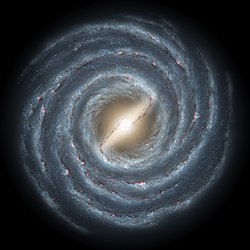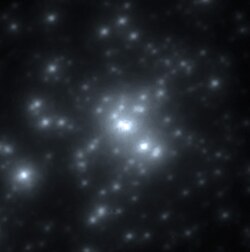HST SN 1987A 20th anniversary
Twenty years ago, astronomers witnessed one of the brightest stellar explosions in more than 400 years. The titanic supernova, called SN 1987A, blazed with the power of 100 million suns for several months following its discovery on Feb. 23, 1987. Observations of SN 1987A, made over the past 20 years by NASA’s Hubble Space Telescope and many other major ground- and space-based telescopes, have significantly changed astronomers' views of how massive stars end their lives. Astronomers credit Hubble's sharp vision with yielding important clues about the massive star's demise.
This Hubble telescope image shows the supernova’s triple-ring system, including the bright spots along the inner ring of gas surrounding the exploded star. A shock wave of material unleashed by the stellar blast is slamming into regions along the inner ring, heating them up, and causing them to glow. The ring, about a light-year across, was probably shed by the star about 20,000 years before it exploded.| This file is in the public domain because it was created by NASA and ESA. NASA Hubble material (and ESA Hubble material prior to 2009) is copyright-free and may be freely used as in the public domain without fee, on the condition that only NASA, STScI, and/or ESA is credited as the source of the material. This license does not apply if ESA material created after 2008 or source material from other organizations is in use. The material was created for NASA by Space Telescope Science Institute under Contract NAS5-26555, or for ESA by the Hubble European Space Agency Information Centre. Copyright statement at hubblesite.org or 2008 copyright statement at spacetelescope.org. For material created by the European Space Agency on the spacetelescope.org site since 2009, use the {{ESA-Hubble}} tag. |
Relevante Bilder
Relevante Artikel
Große Magellansche WolkeDie Große Magellansche Wolke, abgekürzt GMW oder LMC, ist eine Satellitengalaxie der Milchstraße (Galaxis). Sie befindet sich in einer Entfernung von rund 163.000 Lichtjahren zum Sonnensystem. Sie ist das viertgrößte Mitglied der Lokalen Gruppe, nur übertroffen von Milchstraße, Andromeda- und Dreiecksgalaxie. Mit ihren rund 15 Milliarden Sternen kommt sie auf etwa 5 % der Anzahl der Sterne der Milchstraße und dreimal so viele Sterne wie die ihr in vielerlei Hinsicht ähnliche Kleine Magellansche Wolke. Große und Kleine Magellansche Wolke werden zusammenfassend als Magellansche Wolken bezeichnet. .. weiterlesen
SupernovaEine Supernova ist das kurzzeitige, helle Aufleuchten eines massereichen Sterns am Ende seiner Lebenszeit durch eine Explosion, bei welcher der ursprüngliche Stern selbst vernichtet wird. Die Leuchtkraft des Sterns nimmt dabei millionen- bis milliardenfach zu, er wird für kurze Zeit so hell wie eine ganze Galaxie. .. weiterlesen
















